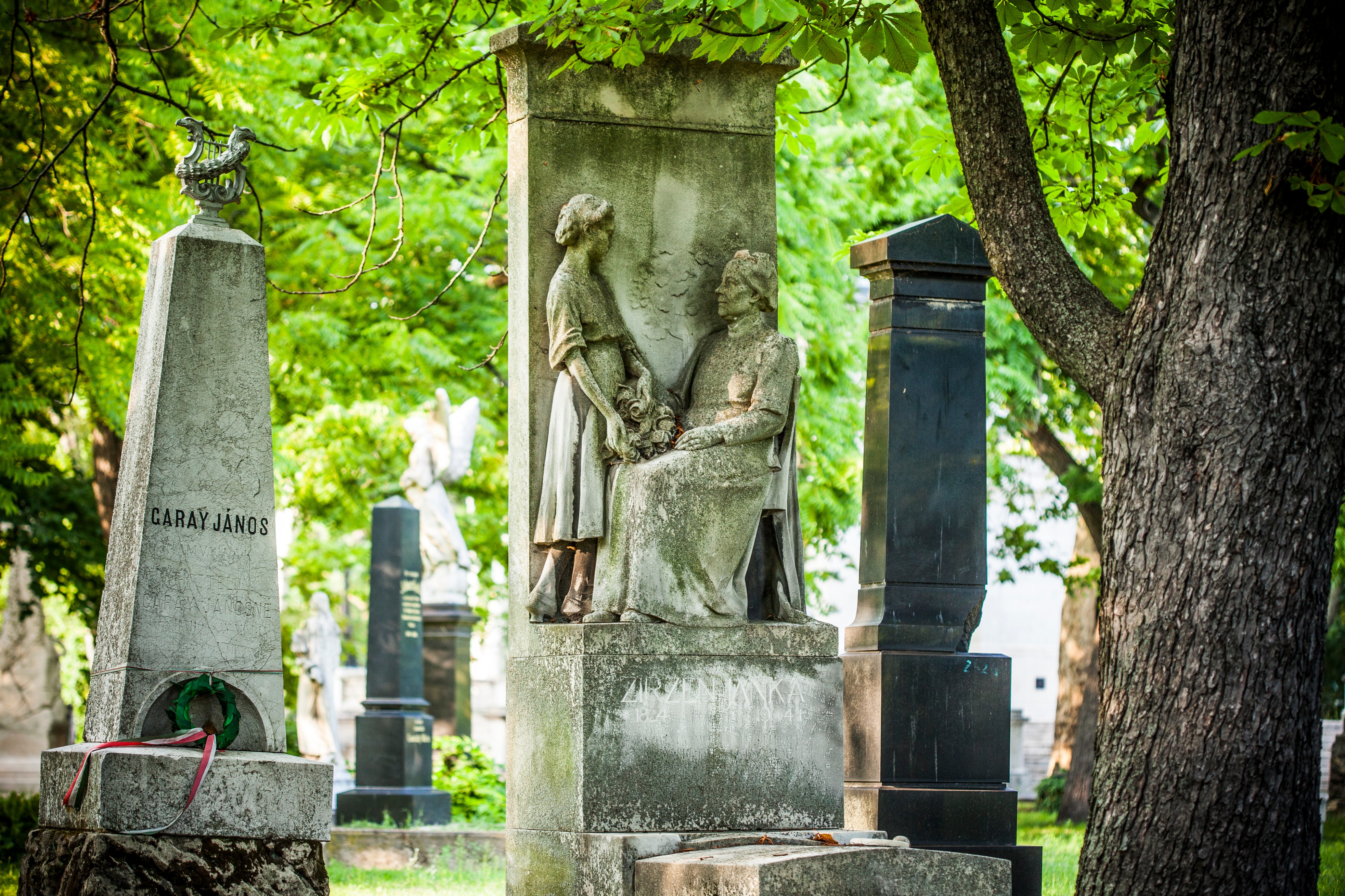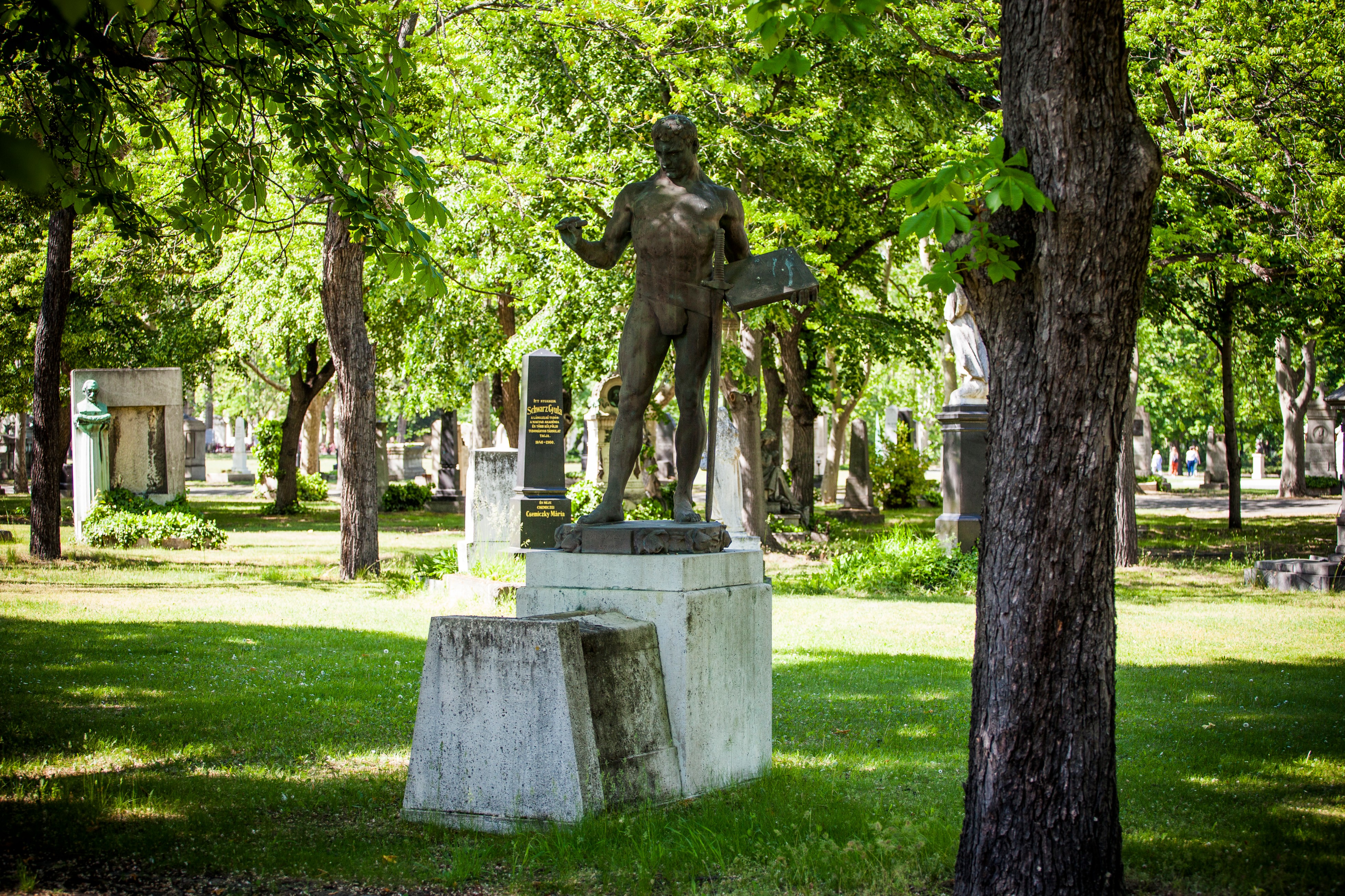
29-1. parcella
Zirzen Janka síremléke, carrarai márvány, 1910 (29/1-1-39)
Szobrász: Bory Jenő
 A több, mint két méter magas carrarai márványból készült síremlék domborműve Zirzen Janka portrészobrát ábrázolja: a pedagógus szék¬ben ül, az előtte álló kis leányka éppen virágcsokrot készül adni neki.
A több, mint két méter magas carrarai márványból készült síremlék domborműve Zirzen Janka portrészobrát ábrázolja: a pedagógus szék¬ben ül, az előtte álló kis leányka éppen virágcsokrot készül adni neki. Bory Jenő (Székesfehérvár, 1879. november 9. – Székesfehérvár, 1959. december 20.)
Bory Jenő hétgyermekes családban nőtt fel, és már középiskolás korában elhatározta, hogy szobrász lesz. Mivel a család anyagi nehézségekkel küzdött, Bory továbbtanulását szülővárosától kapott ösztöndíja tette lehetővé. Először a Magyar Királyi József Nádor Műszaki Egyetemen szerzett építész diplomát, majd beiratkozott a Képzőművészeti Főiskolára, ahol a Stróbl Alajos vezette szobrász mesteriskolát, valamint Székely Bertalan rajzóráit látogatta. Önéletrajzában írta, hogy az „építészet és a szobrászat egy test és egy lélek”, ez lényegében Bory művészi hitvallásának is tekinthető.
Bandika című gyermeket ábrázoló első munkáját 1906-ban a Képzőművészeti Társulat kiállításán mutatták be. Még ebben az évben Németországban és Olaszországban járt tanulmányúton, ahol Carrarában a világhírű Paolo Triscornia műhelyében márványfaragást tanult. Ott szerzett tudásának hazai alkalmazását és átadását fontosnak tartotta, ugyanis korábban a magyar márványszobrokat mind külföldön faragták.
Bory tervei alapján 1909-ben elkezdődött a székesfehérvári Jézus Szíve templom építése, pár évvel később pedig a szobrász nevét viselő Bory-vár építésébe fogott bele, ahol számos munkája megtekinthető. Tanított a Képzőművészeti Főiskolán és a Műegyetemen is, országszerte több köztéri alkotás kötődik a nevéhez. A síremlékszobrászatban is megmutatta tehetségét, ahol össze tudta kapcsolni építészeti és szobrászati felkészültségét. Az első világháború utáni szakrális ábrázolásai jelentősek, ezek közé tartozik a Bitter Illés sírján felállított Szent Imre herceg-szobor a Fiumei úti sírkertben.
Az igazság bajnoka, Tóth Béla síremléke, bronz, 1908 (29/1-1-45)
Szobrász: Ligeti Miklós
 A másfélszeres nagyságú bronzszobor egy erőtől duzza¬dó atléta aktot formáz, aki fejét előreszegve gondolkodó és egyben elszánt tekintettel néz maga elé. Kinyújtott jobbjában „fegyverét”, vagyis íróeszközét tartja, míg baljában könyvlapot, rajta az igazság mérlegével, amely mintegy keretül szolgál a mindent kifejező feliratnak: Esti Levél. A férfi derekán lévő széles övre az igazság egyik szimbóluma, a kard simul. A síremléken az elhunyt nevén túl „Az igazság harcosa” felirat is szerepel.
A másfélszeres nagyságú bronzszobor egy erőtől duzza¬dó atléta aktot formáz, aki fejét előreszegve gondolkodó és egyben elszánt tekintettel néz maga elé. Kinyújtott jobbjában „fegyverét”, vagyis íróeszközét tartja, míg baljában könyvlapot, rajta az igazság mérlegével, amely mintegy keretül szolgál a mindent kifejező feliratnak: Esti Levél. A férfi derekán lévő széles övre az igazság egyik szimbóluma, a kard simul. A síremléken az elhunyt nevén túl „Az igazság harcosa” felirat is szerepel.Ligeti Miklós (Buda, 1871. május 19. – Budapest, 1944. december 10.)
Budán született Lőwy Móricként, édesapja hivatásos katona volt. Az ifjúban rajztanára, Tahy Antal látta meg a tehetséget, az ő közbenjárására került Stróbl Alajos szobrászműhelyébe inasnak. A mester javaslatára az Iparművészeti Iskolába iratkozott, ahol Mátrai Lajos tanítványa lett. Ösztöndíjjal Bécsben, majd Párizsban tanult, ahol Rodin életre szóló hatással volt rá. Hazatérte után megalkotta első köztéri alkotását, a Rákászfiú szobrát, amellyel nemcsak díjra, hanem sikerre is szert tett. Többszöri áthelyezése után a szobor ma a Margitszigeti vízesés medencéjében látható. Legismertebb alkotása, Anonymus városligeti szobra, amely a magyar középkori történelem ismeretlen krónikaírójának egészalakos kompozíciója. Ez az alkotás egyike volt az úgynevezett tíz királyszobornak, amelyeket Ferenc József adományozott a magyar fővárosnak. A fiatal művész ekkor még csak 27 éves volt, és nem pályázat, hanem felkérés útján kapta a megbízást a szobor elkészítésére. Ezzel a szoborral Ligeti új alapokra helyezte a hazai szobrászatot, Fadrusz János szavaival élve, Ligeti ezzel az alkotásával lerakta a talpkövét a hazai új modern művészetnek.
1914-ben Ligeti készítette el az agg Ferenc József utolsó portréját, amelynek végső, befejezett formáját az uralkodó már nem érte meg. Ez a műve egyben egy korszak szimbolikus lezárásának is tekinthető, hiszen a Monarchia széthullott, a város pedig, ahova a szobrot szánták, már nem tartozott Magyarországhoz.
Köztéren felállított szobrai közül többeket az idő viharai pusztítottak el, ezek közül némelyeket újrafaragtak, mint például Déryné Széppataky Róza szobrát a budai Horváth-kertben, vagy ismételten felállítottak, többek között Bandholtz tábornok bronzszobrát a Szabadság téren, Rudolf trónörökös szobrát a Városligetben, Erzsébet királyné márványszobrát Szegeden.
Ligeti Miklós a síremlékművészetben is maradandót alkotott. A Fiumei úti sírkertbe összesen 20 funerális alkotása készült, amelyek közül 19 még ma is a sírkert szobrainak jeles darabjai.
Tomb of Janka Zirzen, Carrara marble, 1910 (29/1-1-39)
Sculptor: Jenő Bory

Jenő Bory (Székesfehérvár, 9 November 1879 – Székesfehérvár, 20 December 1959)
Jenő Bory was raised in a family of six siblings and he decided to follow the path of a sculptor as early as secondary school. Since the family faced financial difficulties, Bory’s continued education was resolved with a scholarship from his hometown. First, he acquired a diploma in architecture at the Hungarian Royal József Nádor Technical University and then he enrolled at the College of Fine Art where he attended sculpting masterclasses by Alajos Stróbl and drawing classes by Bertalan Székely. In his autobiography he wrote that “architecture and sculpting are one body and one soul”; in essence, this can be considered Bory’s artistic creed.
His first work, Bandika depicting a child, was displayed at the exhibition of the Fine Arts Society in 1906. In the same year he undertook study tours in Germany and Italy, where he studied marble carving in the world-famous studio of Paolo Triscornia in Carrara. He considered it important to use and pass on in Hungary the skills he acquired there because earlier all Hungarian marble statues were carved abroad.
Construction of the Jesus Heart Church in Székesfehérvár start in 1909 on the basis of the designs by Bory. A few years later he embarked on the construction of Bory Castle, named after the sculptor, where many of his works can be seen. He taught at the College of Fine Art and the Technical University, and he is associated with several public works to be found throughout Hungary. He also displayed his talent in the field of tombstone and mausoleum sculpting where he was able to exploit both his architectural and sculpting skills. His sacred representations in the period after the First World War are significant, including the statue of Prince St. Emeric erected on the grave of Illés Bitter in Fiumei Road Cemetery.
Champion of truth, tomb of Béla Tóth, bronze, 1908 (29/1-1-45)
Sculptor: Miklós Ligeti
 The one-and-a-half-times life-size bronze statue is a muscular nude athlete looking forward with a thoughtful and determined gaze. In his extended right hand he holds his ‘weapon’, that is, a pen, while in his left there is the page of a book and on it the scales of justice, which serve as a frame for the all-expressive inscription: Esti Levél. A sword, one of the symbols of truth, hangs from a wide belt around the man’s waist. Besides the name of the deceased, the tomb also includes the inscription: ‘Warrior of truth’.
The one-and-a-half-times life-size bronze statue is a muscular nude athlete looking forward with a thoughtful and determined gaze. In his extended right hand he holds his ‘weapon’, that is, a pen, while in his left there is the page of a book and on it the scales of justice, which serve as a frame for the all-expressive inscription: Esti Levél. A sword, one of the symbols of truth, hangs from a wide belt around the man’s waist. Besides the name of the deceased, the tomb also includes the inscription: ‘Warrior of truth’.Miklós Ligeti (Buda, 19 May 1871 – Budapest, 10 December 1944)
Consolidation in the wake of the Compromise, the possibility of freedom, the Millennium celebrations and peace in Europe all sparked growth the like of which had never been seen. The era generated a stratum of patronage that offered a secure livelihood for artists of the turn of the century, and the various world exhibitions and displays also provided opportunities for Hungarian artists to introduce themselves on the international stage. Miklós Ligeti, a highly talented artist blessed with enormous diligence, was born in this flourishing age.
He was born Móric Lőwy in Buda, his father was a career soldier. His teacher of drawing, Antal Tahy, recognized in the youth a significant talent and it was through his efforts that the young man was taken on as an apprentice in the sculpting studio of Alajos Stróbl. At the recommendation of the master, he enrolled at the School of Applied Arts where he was a student of Lajos Mátrai. He won scholarships to study in Vienna and Paris, where Rodin had an influence on him that lasted a lifetime. On his return to Hungary he made his first public statue, Boy Catching Crayfish, which won him not only a prize but considerable renown. After several moves, the statue can be seen today in the waterfall pool on Margaret Island. His most famous work, Anonymous, is in City Park. It is a full-figure composition of the unknown chronicler of Hungarian medieval history. This work is one of the so-called ten royal statues that Franz Joseph donated to the Hungarian municipality. At the time the artist was just 27 years old and he received the commission for the sculpture not through tender but a personal request. With this statue, Ligeti placed domestic sculpting on new foundations. To borrow the words of János Fadrusz, Ligeti had laid the foundation stone of new modern art in Hungary.
In 1914, Ligeti made the last portrait of the old Franz Joseph, the final completed form of which the sovereign did not live to see. This work can also be considered the symbolic closure of an era because the Monarchy collapsed and the city where the statue was destined for no longer belonged to Hungary.
Of his statues in public areas, several have not survived the vicissitudes of time, although some have been remade, for example, that of Róza Széppataky Déryné in Horváth Garden, Buda, or re-erected, including the bronze of General Bandholtz in Szabadság Square, the statue of Crown Prince Rudolf in City Park, and the marble statue of Queen Elizabeth in Szeged.
Miklós Ligeti similarly created great works in the field of tomb art. He made a total of 20 funerary works for Fiumei Road Cemetery, among which 19 still rank as important examples of cemetery sculpture.
Vissza a szoborpark listára